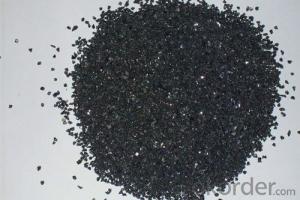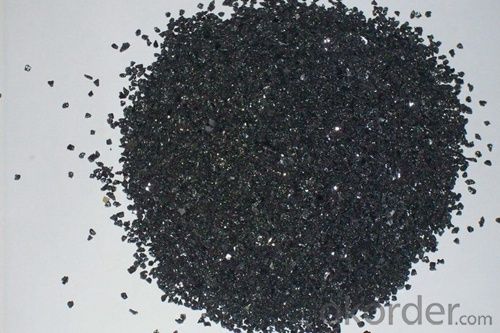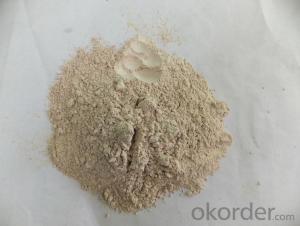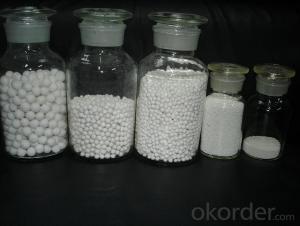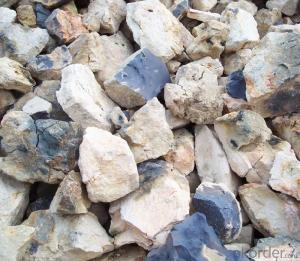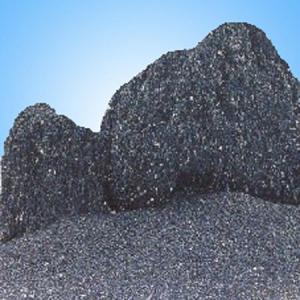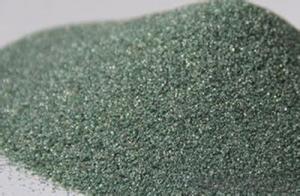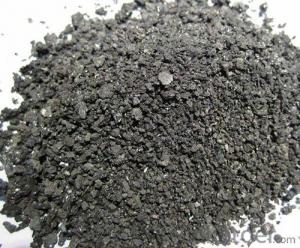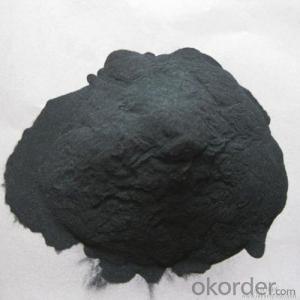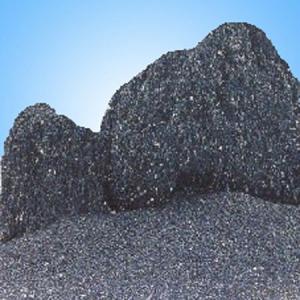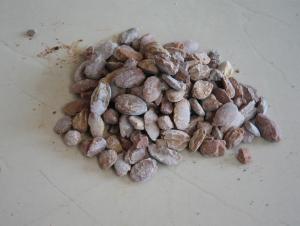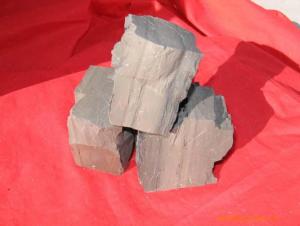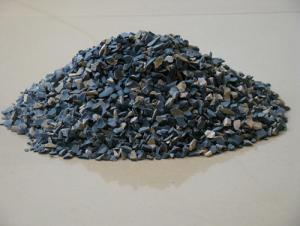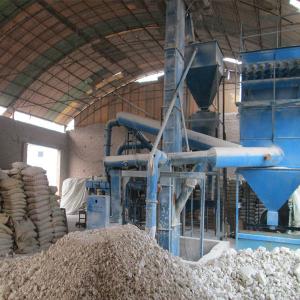Raw Materials for Refractory:Green Silicon Carbide/Carborundum Grit Particle Abrasives
- Loading Port:
- China main port
- Payment Terms:
- TT OR LC
- Min Order Qty:
- 25 m.t.
- Supply Capability:
- 2000 m.t./month
OKorder Service Pledge
OKorder Financial Service
You Might Also Like
Abrasives Raw Material Green Silicon Carbide/Carborundum grit particle
1. Description:
Green silicon carbide is produced in the same way as Black silicon Carbide
except for some differences in raw material. Silicon carbide is an extremely hard
material (Mohs hardness 9.4), is chemically inert and does not melt. Silicon Carbide
has a high thermal conductivity, a low coefficient of thermal expansion, is thermal
shock and abrasion resistant and has strength at high temperatures.
2. Sizes:
Grits: F#8, F#10, F#12, F#16, F#24, F#30, F#36, F#40, F#46, F#54, F#60,
F#70, F#80, F#90, F#100, F#120, F#150, F#180, F#220
Powder: F#230, F#240, F#280, F#320, F#360, F#400, F#500, F#600,
F#800, F#1000, F#1200, F#1500, F#1800, F#2000
3. Chemical & Physical features:
Chemical compositions | Physical properties | ||
Items | Value of specification (%) | Items | Property |
SIC | 99.1min | Color | Green |
Melting point | 2250°C | ||
F.C. | 0.20max | Hardness | 9.5 |
Bulk density | ≥1.38g/cm3 | ||
Fe2O3 | 0.20max | Real density | 3.9 g/cm3 min |
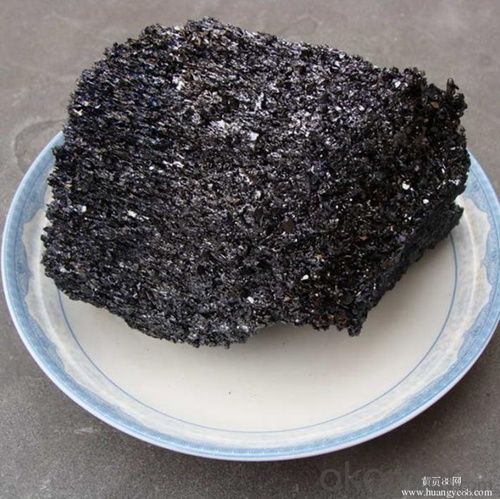
- Q: Does anyone know what kind of light fireproof materials are there?
- 二, 1, Gypsum plaster board With the building plaster as main raw material, gypsum plaster board is a kind of processed plate made by a special board for protective with an addition of additives and fibers as board core. Gypsum plaster board is characterized by light weight, sound insulation, heat insulation, strong processing performance and simple construction method. 2, Gypsum block Gypsum block is a kind of lightweight building gypsum product which is mainly made of building gypsum, and by adding water, stirring, casting and drying. During the process, , the fiber reinforced materials or light aggregates are allowed in, and the foaming agent can also be added. It has many advantages, such as sound insulation and fire prevention, convenient construction and so on. It is a kind of new and healthy wall material which produces low carbon, enhances environmental protection, and caters to the the times. 3, Fly ash brick is a new type of wall material, and bulk density is one of the main technical indexes. The weight of bulk density can be controlled according to the need of construction and adjustment of technical formula. The dry bulk density of the fly ash brick is about 1540 to 1640 kg / m 3, slightly lighter than the clay brick (1601800 kg /m 3). The flexural and compressive strength of fly ash brick is mainly determined by the production process, the formula and the hydrothermal synthesis reaction mode as well as the need of construction. According to the standards of architectural material industry (JC239 - 2001) released by People's Republic of China, the average value of the flexural strength is 2.5 ~ 6.2Mpa, compressive strength is between 10 ~ 30Mpa. I hope this will be helpful to you
- Q: How to classify the grade of wall fireproof and thermal inuslation matertial?
- External wall thermal insulation materials are mainly divided into grade A, grade B1, grade B2 and grade B3. In accordance with the current "Combustion Performance Classification Method of Building Materials", grade A thermal insulation material is incombustible?material and belongs to inorganic heat preservation material. However, grade A thermal insulation material is few in terms of the current market. There are only JETCO YT inorganic active wall thermal insulation material, glass wool, rock wool board, foam glass, vitrified micro bead and grade A fireproofing thermal insulation board. However, compared with grade A thermal insulation material, the more welcomed by the market is the organic insulation materials. Thermal insulation material that is determined as grade B is divided into three levels. Grade B1 is grade is flame retardant. Grade B2 is combustible. Grade B3 is flammable.
- Q: What is the role of the vermiculite fireproof material?
- Apart from inflaming retarding, the materials covered with vermiculite has a lot of advantages including anti rust, waterproof, anticorrosive, wear-resisting, heat-resisting and the coating is armed with toughness, colorability, adhesiveness, fast-drying and luster.
- Q: Who knows the new fireproof and thermal inuslation matertial?
- New fire insulation material, having a foam material body, with the following characters: Outside of the foam material body bonds the aluminium foil composite glass fiber cloth, which is bonded by the aluminium foil and glass fiber cloth through fireproof glue. The utility model has the following advantages: Bonding the aluminum foil composite glass fiber cloth to the outer surface of the foam insulation material, will strengthen thermal insulation index, also will prevent the burning of the foamed material, thus ensuring the fireproofing safety of the foam insulation material.
- Q: What's the fire resistance test method of doors and roller shutters?
- Fire resistance test method of doors and roller shutters: This standard specifies the fire resistance test method for roller shutter doors under standard fire conditions. The method is used to test the fire resistance of the ventilating duct when bearing the external fire (A duct) and internal fire (B duct). Fire resistance test of vertical ducts may be conducted referring to this standard. 1.Test specimen1.1 The test specimen is obtained by cutting from any part of the qualified metal tube unless otherwise relevant standard or mutual agreement specifies the cutting position of the metal tube. 1.2 Length of the specimen: L≈2.5D+50mm (D: outer diameter of the metal tube). The cut surface of the specimen must be perpendicular to the axis of the metal , and the seamed edge of the cut should be round off. Test method GB243-82 of metal tube necking 2. Test procedures 2.1 In the test, punch or press the metal tube into the tapered conical seat (see Figure) with a hammer or press machine, and make it uniformly diminished to the regulated shrinkage X which is calculated according to the following formula: Test method GB243-822 for metallic pipe necking: The inner wall of the seat cover used in the test should be polished, and has certain hardness and is coated with lubricating oil. Its conicity is 1:10, 1:5 or others in accordance with relevant standard provisions. If there is no provision, then adopt the conicity of 1:10. This standard is not suitable for: a) The pipeline whose fire resistance depends on the fire resistance of the ceiling; b) The pipeline with access door, unless otherwise the access door is included into the pipeline and tested together; c) The pipeline with two or three sides; d) Fume exhaust pipes;
- Q: What are the specifications of fireclay bricks?
- Specifications of fireclay bricks are shown in the figure;
- Q: What are fire resistant level standards of class A fire resistant door?
- Situations under which fire endurance should at least meet class A fire resistant door standard: In basement, the fire door for room where the stored combustibles average weight exceeds 30kg/㎡; in partition basement, the fire door for partition of room where the stored combustibles average weight exceeds 30kg/㎡; in high building, the fire door for equipment room of automatic fire extinguishing system, fan room and air-conditioner room; in boiler room, transformer?cabin, diesel?generator room(other dangerous rooms), the fire door in firewall. These places are special and need high security, so they need to meet the standard of class A fire resistant door. What is class A fire resistant door? New Standard for Fire Door GB12955-2008 provides that class A fire resistant door thermal insulation and refractory integrity should be no less than 1.5 hours. In other words, the key of fire door grade is the fire-resistant time. Class A fire resistant door size: class A fire resistant doors have many sizes, and can be customized according to the needs of customers. For example, the size of some fire doors of the diesel generator room is large, while the size of fire doors of basement storing combustibles is small. So the size of class A fire resistant door is also different. Usually Xinduo will take this into account, produce class A fire resistant door with various sizes and can customize according to customer requirements. Class A fire resistant door standard: as is mentioned above, for class A fire resistant door standard, the key is the fire resistant time, no less than 1.5 hours. In texture, class A fire resistant door standard is manifested in the firm joint, uniform distribution of solder joints and smooth surface coating. It has also set fireproof sealing strip which should be straight.
- Q: About the use of horseshoe glass kiln refractories
- the lower portion of advanced clay brick, the lower portion of magnesia-chrome brick arch - high-purity silica brick; flue - clay brick; breast wall--33 # fused zirconia corundum brick (with shrinkage); fused zirconia bottom --33 # fused zirconia corundum brick (with shrinkage); regenerative chamber- the upper part of sintered magnesia-chrome brick, cooling section 33 # electric?smelting no shrinkage fused zirconia corundum brick; the wall - the melting section 41 # no shrinkage fused zirconia corundum brick (including 41% of zirconium; the lattice- superstructure of high purity magnesia brick, the same below); small stove --33 # fused zirconia corundum brick (with shrinkage). It can be said that it is the maximum configuration, if the funds is limited it can be downshift appropriately.
Send your message to us
Raw Materials for Refractory:Green Silicon Carbide/Carborundum Grit Particle Abrasives
- Loading Port:
- China main port
- Payment Terms:
- TT OR LC
- Min Order Qty:
- 25 m.t.
- Supply Capability:
- 2000 m.t./month
OKorder Service Pledge
OKorder Financial Service
Similar products
Hot products
Hot Searches
Related keywords
